The Wise Hoopoe: Sunday Morning Quran Bird Study VII
King Solomon, Queen Sheba, and the Hoopoe
Link to entire 10-blog Birds in the Bible series on one page
Once upon a time, says the Quran, a Hoopoe was King Solomon’s personal messenger.
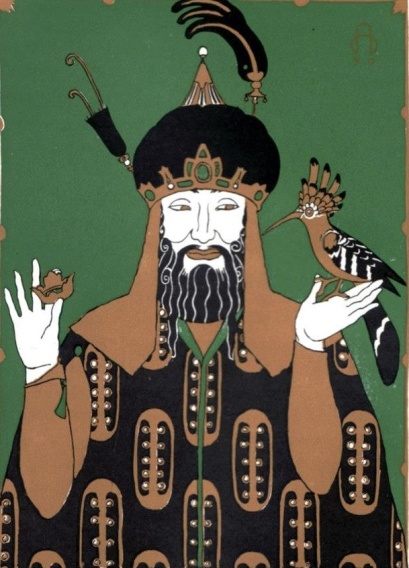
The Hoopoe – explorer, spy & messenger all rolled into one – sits on King Solomon’s hand (Google – Pinterest)
“And [Solomon] reviewed the birds, and he said, ‘Why do I not see the hoopoe (الْهُدْهُدَ), or is he of those absent? I shall surely punish him severely or slay him, or he must come to me with a clear excuse.’ But [the hoopoe] was not long in coming, and it said, ‘I have found out what you have not apprehended, and I come to you from Sheba with tidings!’ (Quran 27:20-22).” The bird reported that Sheba was ruled by a powerful and wealthy Queen who had a magnificent throne. But they worshipped the sun, which disturbed Solomon. Solomon sent the hoopoe back to the Queen with a letter, inviting her and her people to the worship of the one true God. Ultimately, Queen Sheba renounced idolatry and joined Solomon in worshiping God.
Solomon seems to have been a little testy with his employees. Other sources report that Solomon and the Queen got up to a lot more than the “worship of God,” but I doubt the Hoopoe was involved so we won’t dwell on it.
In researching the Hoopoe in the Bible, I ran across this story from the Quran. It is interesting in its own right, it gives us a chance to take a brief look at this culturally foundational text, and it’s illuminating to compare these two books with respect to how they present material.

Bilquis, Queen of Sheba, gets a letter from King Solomon by means of his trusty Hoopoe. c. 1595, artist unknown, falsely attributed to Bihzad Iran, Safavid, Qazvin (Wikipedia)
The land of Sheba, depending on your source, was in Arabia, Ethiopia, Egypt, Nigeria, Iran, somewhere north of Assyria (whence the name Syria), or nowhere at all. Sheba could have been Saba in what is now Yemen. Take your pick. This sort of uncertainty of “facts,” or of incompatible certainties, brings us to something interesting about humans as a species.
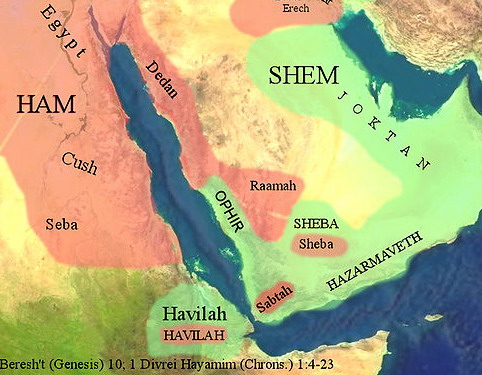
Map showing two of the many lands of Sheba or Seba. (Britam.org)
When we previously considered the problems presented by the stories of the two Bar-Abbas, and Elijah and his “friendly ravens,” we were doing a simple form of text analysis; we looked at alternative interpretations of the texts and reasons why they might have been written as they were. Writers write for human reasons. Their reasons may proliferate into the hundreds, yet we, as fellow humans, may sometimes ferret out something interesting by looking at what they wrote. We did this with Christian and Jewish scriptures; it’s only fair that we look at this Quranic story as well.
I couldn’t determine from the source link which translation from Arabic Quran they used. Its English is more modern (“surely“, not “verily“; “not apprehended“, not “apprehendest not“) than in my 1930 version, but otherwise equivalent.
The official Islamic view is “every single letter and word in the Koran comes directly from God” [Shadi Hamid, Los Angeles Times] [1], a view which out-fundamentalizes any Christian fundamentalist. Pew Research [2] has surveyed religious views, including Islamic, world-wide. In sub-Saharan Africa, the only region where respondents were asked whether they consider the Quran to be the word of God, they found “more than nine-in-ten Muslims say the Quran is the word of God, and solid majorities say it should be taken literally, word for word.” They did not ask that exact question of American Muslims, but found that 37% believe that there is only one true way [3] to interpret the teachings of Islam (28% of U.S. Christians believe that about Christianity). So we’ll take this viewpoint into consideration.
We’re going to look at this Surah (chapter) no. 27, given the title “The Ant,” which belongs to what’s known as the “middle group of Meccan surahs.” If you’ve never read any of the Quran (Koran, Q’ran), now’s your chance to be able to honestly say you’ve read some of it. Two good (it seems to me) translations are Clear Quran and Noble Quran. This surah has 93 verses and can be read in five minutes.
Very roughly, this surah is a sequential and rapid list of events in Jewish biblical history, which pauses only when arriving at King Solomon. Verses 1-15 consists of promises to unbelievers (unpleasant) and believers (pleasant), mixed with Allah’s frequent self-references – beneficent, merciful, mighty, wise, lord of the worlds, etc. Verses 16-44 pertain to Solomon, the Hoopoe and Queen Sheba. Verses 45-93 continue the rapid historical recitation, promises pleasant and unpleasant, and self-descriptions.

Gina Lollobrigida looks neither Ethiopian nor Yemeni. Note absence of the Hoopoe. (FFFMoviePosters.com)
Solomon is not a likable character. He is setting about to conquer whatever remains unconquered and is mustering his troops – avian, djinn (genies – intelligent spirits lower than angels) and human – and fulminating at the Hoopoe’s absence. The Hoopoe returns, tells his tale, and after delivering Solomon’s message to Sheba, vanishes from the story. Perhaps he wisely decided he’d had his fill of servitude under Solomon, a terrible boss, whatever his religious predilections might be. Sheba does not look forward to meeting Solomon and she tries to buy him off with expensive gifts. He then steals her beautiful throne and tells her it’s a replica when he later shows it to her. Somehow this and the shiny marble floor of Solomon’s palace convince Sheba to accept Solomon’s monotheism. After this, the surah takes a sharp left turn and Solomon and Sheba vanish as well.
[INTERJECTED NOTE: On 11 October, 2019, I received the following note from “Tuppence” <twopennyposts@gmail.com> (a “tuppence” is an almost-archaic Britishism for a two-penny coin), which I reproduce here in its entirety.
Hello Mr. Almdale,
It’s been a few years now since you did that Bible Birds series. I stumbled across your post about the Quran’s story of Solomon and the Hoopoe. It was very entertaining. I’ve been doing a Quran series myself and just studied this surah. Something that would help you understand the story a little more is to know that it is copying a document known as “The Colloquy of Sheba.” The manuscript we have does post-date the Quran, but Solomon-Sheba fanfics* are pretty old and I’d say by reading it that the Quran was referencing an older work.
https://en.wikisource.org/wiki/Translation:Colloquy_of_the_Queen_of_Sheba#cite_ref-18
The Quran is toning down the bizarreness of the story for the most part, while simultaneously assuming its audience knew the story enough to fill in gaps in the details. Or at least, that’s how I made sense of it. Anyhow, trivia on a post I’m sure is long dead in your concern. But thanks for posting! – Tuppence
Link to Tuppence posting on Quran Surah 27 “The Ant”
*“Fanfics” is a neologistic portmanteau for “fan fiction,” defined as “any kind of work that is inspired by books, films, TV shows, music, and celebrities. It’s created and published by fans of the original work.” Tuppence’s comment does not make me want to change anything I’ve written in this article but it does raise a question. As “Colloquy of the Queen of Sheba and King Solomon” (title on the linked document) is dated to circa 800 C.E., and Muhammad died in 632 C.E., it makes things awkward. Perhaps he wrote this from beyond the grave, or the document is based on the surah, or both document and surah are based on an earlier version of the story. Whatever happened, it doesn’t lend much support towards the belief that every letter, or even every word, in the Quran comes directly from God. END OF NOTE.]
There are several problems with this story and its presentation. If this is literally from the mouth of a deity, as most Moslems maintain, it’s a very odd story, especially as it’s tucked into a litany of that deity’s own marvelous deeds and qualities. Solomon may be a powerful and religious king, but otherwise he seems poorly socialized. Sheba appears too easily persuaded by his thievery; more likely she’s stroking his masculine ego in order to avoid his laying waste to her land (27:34) with his army. Why is a deity telling us this story and in this form? Are we supposed to believe that these events actually happened as described, or is it a divine illustration of what submission to that deity’s will should look like and the wonderful things that befalls those who submit?
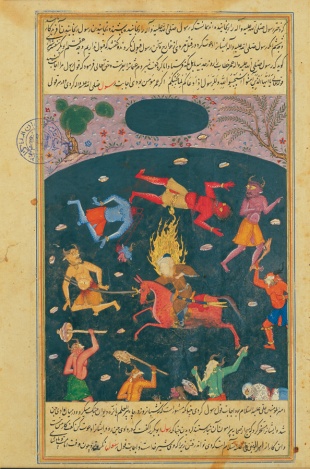
Imam Ali and the Jinn, 1568, Unknown Artist, Ahsan-ol-Kobar, Golestan Palace (Wikipedia)
First, we’ll assume the details are literally true. Are we supposed to believe that Solomon really had birds he could understand, knew the language of the ants, had genies in his army? Without flogging this assumption too much, it seems unacceptable that an infinite creator deity, lord of the worlds, would actually want and expect us to believe this story to be literally true. The content and form of the surah seems well below the capabilities of such a deity.
Second, we’ll assume this is a divine metaphor. If so, it’s a strange metaphor. We’re supposed to admire or emulate this depiction of Solomon? He is not a good person, and the depiction seems more degrading than exalting. Perhaps we’re supposed to understand that the deity will reward anyone who properly submits, even this greedy liar. I have more respect for wily survivor Sheba, and admiration for my hero of the tale, the Hoopoe. He got out. He probably lived out his days in Ethiopia, feeding fat grubs to his lovely children and bill-rubbing with his lady friend, far from the dangerous company of unworthy men. That is, of course, assuming that any of this entire story actually happened.

Hoopoe feeds the young one, Israel
(Artemy Voikhansky – Wiki Commons)

Magyar Posta (Hungary) 2010 stamp, Aladdin and the Jinn (Wikipedia)
The last possibility is that both assumptions above are false. This story is human-made, for human purposes. As this view does not ascribe peculiar qualities – especially with respect to the storytelling ability or self-absorption of an infinite creator deity – it seems the most acceptable view. A human or humans wrote it. Why did they write it in this peculiar, disjointed, episodic form?
I’m not the first reader to have a problem with this text. The translator of my Quran copy, Mohammed Marmaduke Pickthall, (and here) prefaced this surah:
Some commentators, objecting to the miraculous, seek to explain the ants, in the story of Solomon, as an old Arab tribe, the birds as cavalry, Hudhud (the hoopoe) as a man’s name, and the Jinn as foreign troops.
Aristotle wrote in his “Poetics” (Part IX):
Of all plots and actions the episodic are the worst. I call a plot ‘episodic’ in which the episodes or acts succeed one another without probable or necessary sequence. Bad poets compose such pieces by their own fault…
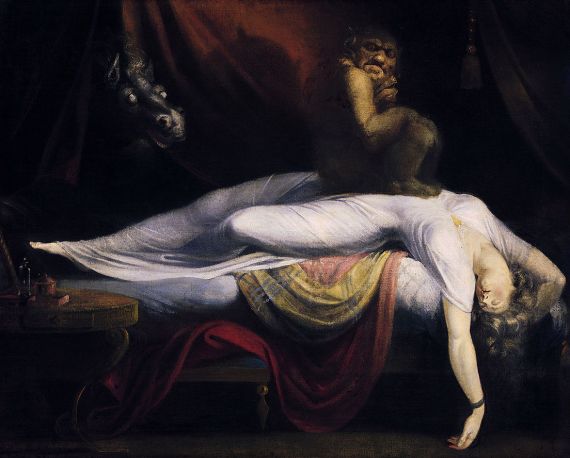
The Nightmare by John Henry Fuseli, 1781
(Detroit Museum of Art via Wikipedia)
I suggest that the form of this surah reflects its origin in a dream. Dreams often abruptly introduce characters and events; these may suddenly morph into other characters and events; people fly, animals and inanimate objects talk, angels or spirits of the dead appear and vanish; scenes evaporate and new scenes appear; people encounter gods and demons, and it all seems perfectly normal and true until the dreamer awakes.
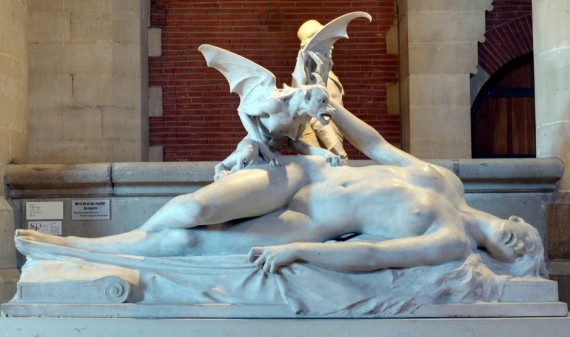
Le Cauchemar – Eugene Thivier, 1894. In centuries past, hypnagogic dreams often included the sensation of an evil demon sitting on one’s torso.
(The Atlantic – Sleep Paralysis)
The hypnagogic dream – occurring between true dreaming sleep and true wakefulness – may contain any of the above, but with a critical added factor: the dreamer believes they are awake. Not just believes, but knows for certain they are awake and the dream is marvelously – or horribly – true. Even after the dreamer truly wakes and the hypnagogic state ends, this feeling of conviction of the dream’s truth continues – for hours, days, weeks, years, sometimes for a lifetime.

Modern hypnagogic dreams often manifest as abduction from your bed by extraterrestrials (EducatingHumanity.com)
(See also 72 Possible Signs of Alien Abduction)
As with any human trait, ability or defect, some people express, utilize or suffer with it more than others. This surah’s form – a rambling episodic narration abruptly morphing into a strange story with magical characters and peculiar illogical events, then equally abruptly reverting to the rambling narration – is dreamlike in every respect. I suggest that this surah originated in a hypnagogic dream and, as is characteristic of such dreams, the dreamer emerged from the dream convinced of the absolute reality of the dream. That they likely remained forever so convinced is demonstrated by the fact that the story exists at all. Most dreams are forgotten shortly after the dreamer awakes. Only dreams remarkable for content, clarity or emotional impact are retained in memory, related to others, perhaps even written down for posterity. The following famous story of Chuang Tzu, perhaps the greatest Taoist philosopher after Lao Tzu, illustrates this state of simultaneous certainty of two incompatible interpretations of reality, a state commonly engendered by the hypnagogic dream.
I, Chuang Tzu, dreamed I was a butterfly, flitting about happily enjoying myself. I didn’t know I was Chuang Tzu. Suddenly I awoke, and now I no longer know whether I am Chuang Tzu, who dreamed I was a butterfly, or whether I am a butterfly now dreaming that I am Chuang Tzu.
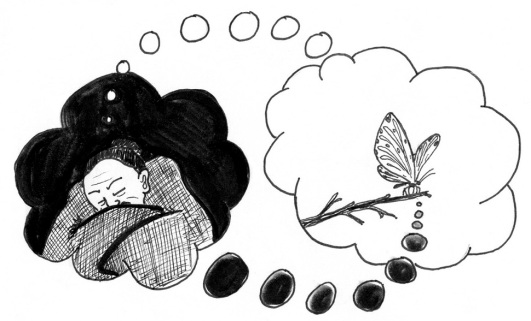
Dream within a dream?: Butterfly and Chang Zhu each dream they are the other (LikeSuccess)
Bible Factoid #7 – On “On”
Somewhere between three and six in the morning, seeing them laboring at the oars against a head-wind, he came towards them, walking on the lake. He was going to pass them by: but when they saw him walking on the lake, they thought it was a ghost and cried out: for they all saw him and were terrified. But at once he spoke to them: ‘Take heart! It is I; do not be afraid.’ Mark 6:48-50 New English Bible
Let’s compare that to a facsimile (PDF File, facsimile pg 1263) of the original 1611 King James Bible.
And he saw them toiling in rowing (for the wind was contrary unto them:) and about the fourth watch of the night, he commeth unto them, walking upon the Sea, and would have passed by them. But when they saw him walking upon the Sea, they supposed it had bene a spirit, and cried out. (For they all saw him, and were troubled) and immediately he talked with them, and saith unto them, Be of good cheer, It is I, be not afraid. Mark 6:48-49
The English used is obviously separated by centuries, but otherwise differences are minor. If you look at the linked PDF, facsimile pg 1263 facsimile, you’ll see that the small letter “s” looks like “f”, just as in facsimiles of the American Declaration of Independence.

2000 year-old fishing boat found at Sea of Galilee 1986 (drblyisrael15)
The Greek word for “on” (ἐπὶ “epi”) occurs 669 times in the New Testament. This preposition locates something in time or space, and is translated in the New Testament from Koine Greek into these English words: about, above, against, after, along, among, over, at, because, before, being, by, during, for, from, in, into, in the time, on, out onto, over, throughout, to, together, toward, upon, up against, wherefore.
Biblical “literalists” read this as saying Jesus could and did walk “on” the water; he was the Son of God and therefore above mere laws of nature. [That choosing “on” for one’s “literal” translation is a misleading misnomer, when the New Testament itself uses twenty-eight ways of translating ἐπὶ “epi.”] Albert Schweitzer differed, holding that the disciples saw Jesus walking on the seashore, but high winds, waves and darkness hid the low-lying shore from them. Theologian David Friedrich Strauss saw it as a metaphorical myth: the storm is the vicissitudes of life, above which only Jesus can rise.
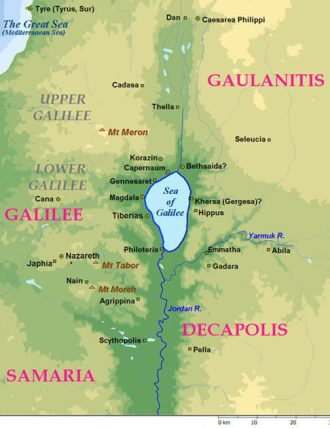
Sea of Galilee in New Testament times (GodsWordFirst)
Mark wrote Jesus “was going to pass them by.” This detail was omitted in Matthew 14:24-26 and John 6:18-20, written later, using Mark as a source. This is a strange detail, making the story more dreamlike, as with the Koranic tale of the Hoopoe and Solomon discussed above. Jesus just happens to be walking on the surface of the Sea of Galilee and would walk right on by a boat filled with his friends while they struggle with the waves and wind, yet say nothing to them? Some commentators hold that Matthew and John intentionally edited that out because it made no sense.
The simplest solution is that the Greek preposition ἐπὶ – “epi” is mistranslated in this story. It should not be “on;” but “by,” “around,” “near,” or “along.” If Jesus didn’t notice them it was because he was busily picking his way down the storm-tossed beach, likely deep in thought. Some writers suggest that someone, somewhere, some when (opinions differ) chose “on” because it added to a desired presentation of Jesus as more than human.
Part I – What About That Dove? & The Flood of the Gilgamesh
Part II – Sandgrouse or Quail? & YHVH [יְהוָ֖ה] [Yahweh]
Part III – Junglefowl in Judea! & New Testament Koine Greek
Part IV – Birds that Sow, Reap and Store & Whence Jesus (Ἰησοῦς)
Part V – The Friendly Raven & The Bar-Abbas Mystery
Part VI – The Humble Hoopoe & Catching “Forty” Winks
Part VIII –Don’t Eat That Bird! Part 1 & Of “Of”
Part IX – Don’t Eat that Bird! Part 2 & Seeing “Red”
Part X – Don’t Eat that Bird! The Last Bite & The Problems of Translation
[Chuck Almdale]
Additional Sources:
1. Meaning of the Glorious Koran, The. Tickthall, Mohammed Marmaduke. (No date) Mentor/New American Library, New York.
2. New English Bible with the Apocrypha, The, Oxford Study Edition. Sandmel, Samuel, Suggs, M. Jack, Tkacik, Arnold J.; eds. (1972) Oxford University Press, New York
3. Random House Dictionary of the English Language. Stein, Jess, Ed. (1967) Random House, New York
Sources with Links
[1] “Why Islam isn’t like other faiths,” Shadi Hamid. Los Angeles Times, 9-15-16. Author is a senior fellow at the Brookings Institution and the author of “Islamic Exceptionalism: How the Struggle Over Islam is Reshaping the World.”
[2] Pew Forum Research, “The World’s Muslims: Unity and Diversity.” Aug 8, 2012. Section “Core Beliefs,” paragraph two and graph “Quran is God’s Word,” based on research 2008-09 “Tolerance and Tension: Islam and Christianity in Sub-Saharan Africa.”
[3] Pew Forum Research, “Muslim Americans: No Signs of Growth in Alienation or Support for Extremism.” Aug 30, 2011. Section “Religious but not Dogmatic,” paragraph three and graph “American Muslims & Christians.”



Trackbacks